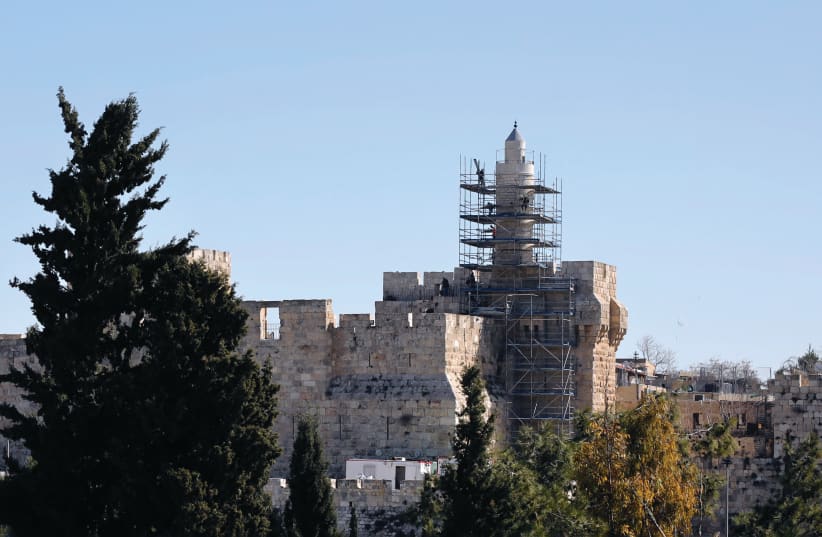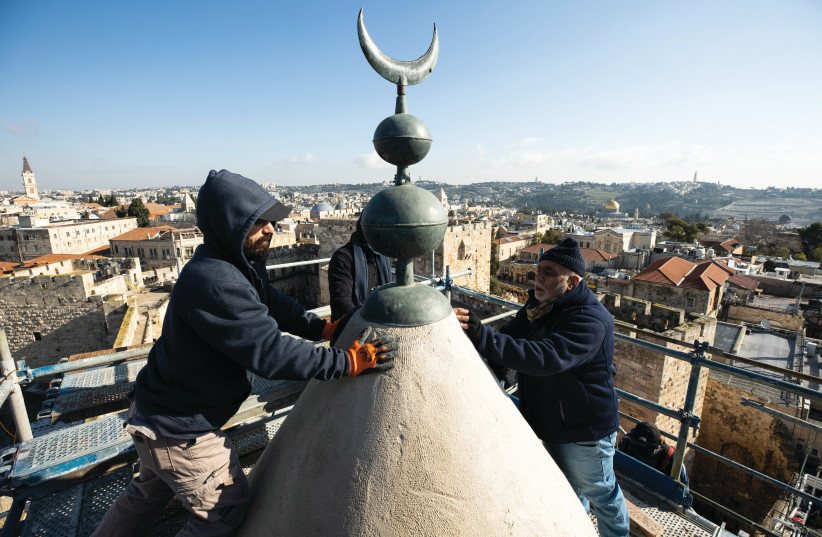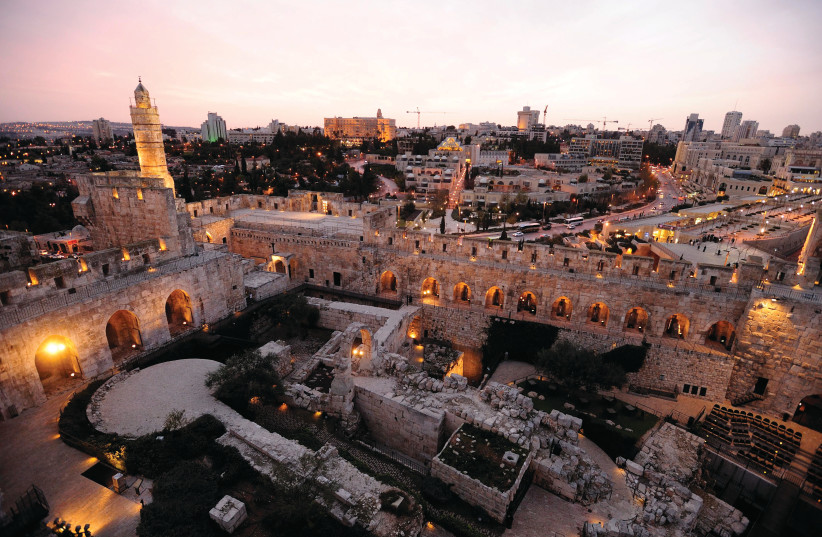As enduring landmarks go, the minaret of the Tower of David in Jerusalem has most of them beat. The rotund spire that sits just a stone’s throw from Jaffa Gate has stood sentinel among the Old City ramparts for nigh on 400 years – some say longer.
Visitors to this region over the decades and centuries, tourists and pilgrims alike, have gained their first sighting of the ancient city and the walls that have kept numerous invaders at bay, for a while at least, as the minaret hove into imposing view.
It must be said, it has made for an alluring spectacle, with its gray-white stonework and trim cylindrical shape climbing high above the environs. And, for anyone with the inclination and requisite physical fitness, the top offers a singular panoramic view of the entire Old City and beyond to the east, as well as parts of west Jerusalem.
Visiting the Tower of David minaret before the repairs were finished
I had the privilege of sampling that for myself when I visited the citadel recently, just days before extensive repair and restoration work on the tower was completed. Had you driven, cycled or walked in the vicinity anytime over the past eight or nine months and looked up, you would have caught a strange sight.
Instead of the familiar unobstructed view of the curvaceous, almost mystical, lines of the minaret, you would have espied the tower through the skeletal rectangular frame of scaffolding that ran the full height up to the bulbous copper and crescent rooftop ornamentation.
I got to see those appendages from very close quarters when I climbed up the narrow spiral stairwell of the minaret, accompanied by Tower of David director of maintenance Yehuda Vaknin. It was quite an experience. I was duly taken with the 360-degree bird’s eye view of the history-drenched area, and with the scars I saw in the copper orbs. “Those are bullet holes and dents,” Vaknin chuckled, “from the Six Day War.”
As we well know, this part of the world has seen its fair share of altercations over the millennia, as empires from Europe and Asia and other civilizations tried to wrest the holy city from the occupying power du jour. The minaret has taken several shots across its bows and into its stonework since it was constructed in 1635, as current confirmed evidence has it, and has somehow survived.
But time, the elements and other factors, including the odd regional earthquake, have taken their toll. Last year, the Tower of David Museum, together with the Conservation Department of the Israel Antiquities Authority (IAA), decided it was high time something was done about the crumbling iconic edifice.
Early last century, the British Mandate authorities realized urgent action was then required and implanted giant iron braces to steady the minaret. This time the minaret was going to get a very thoroughfare refit, as part of an expansive three-year $50 million conservation and renewal program of the entire Citadel.YOSSI VAKNIN, who oversaw the repair and restoration venture on behalf of the IAA, notes that the archeology authority has had its finger on the Tower of David’s pulse for some time before getting down to brass tacks. “The process, in fact, started in the 1980s. We have been monitoring the tower, and its engineering condition, since then. In June 2022 we got to the point when, after we climbed up the tower, we realized it needed pretty urgent significant treatment.”
Naturally, this wasn’t any old structure that needed a bit of shoring up, and a general makeover. The Tower of David minaret is an ancient edifice built by the Ottomans. It was an addition to an existing compound, the Tower of David citadel, the majority of which was built during the Middle Ages.
That, in turn, was constructed on top of King Herod’s palace, the walls of the Hasmonean Kingdom, and the great wall of Jerusalem from the time of King Hezekiah during the First Temple Period 3,000 years ago. It is a time-honored process of stratification familiar to all archeologists.
Those with a penchant for historical research may know that the name the Tower of David was originally associated with one of King Herod’s imposing towers built 2,000 years ago on top of the existing Hasmonean elements. That structure, which lies a little to the east of Jaffa Gate, was originally called Phasael Tower by Herod, in honor of his brother.
Making sure the minaret was in good health, and could remain open to the public, involved close attention to detail and support by professionals with the requisite knowledge and professional experience. It wasn’t just a matter of sending in the repair gang to plug up cracks and reinforce the structure. There was plenty of groundwork to get done before they got to grips with the on-site situation.
“The work of conservation requires a high degree of skill, knowledge and a deep understanding of early building techniques,” Vaknin notes. “Before beginning preservation work on the minaret, the project conducted thorough research and investigations to ensure the stability of the archaeological remains and the minaret for many years to come.”
While the torso of the tower presented the conservation professionals with a challenge, Yossi Vaknin says the complexity ante jumped a couple of notches when they got around to addressing the apex of the building. “The most important part was reconstructing the uppermost level, the gallery level. It was a very gradual and precise conservation process.”
That entailed building a model in a masonry plant, to make sure they had absolutely every detail in place, and materials matched, before putting the dry run into practice in situ. “According to the conservation rules we are obliged to stick to the plan of the original building.” Vaknin continues. “On the one hand we restore the building, but we also have to mark the new construction so there is clear demarcation between the restoration work and the original structure.” Considering the rich historical backdrop to the place, that makes perfect sense.
The importance of the Tower of David in historical, cultural and aesthetic terms
IF ANYONE is keenly aware of the importance of the Tower of David, in historical, cultural and aesthetic terms, it is Eilat Lieber, Director and Chief Curator of the Tower of David Museum. She welcomed the conservation project and says the work represents a game changer in the site’s millennia-long timeline.
“We have been given the historic opportunity to preserve for future generations the Tower of David, the minaret of the Citadel and the symbol of the city of Jerusalem, standing at the entrance of the Old City and receiving visitors from 1635 until modern times,” she says.
“We have been given the historic opportunity to preserve for future generations the Tower of David, the minaret of the Citadel and the symbol of the city of Jerusalem, standing at the entrance of the Old City and receiving visitors from 1635 until modern times.”
Eilat Lieber
One only has to take a look at sepia postcards from around the turn of the 20th century, not to mention earlier lithographs by famed Scottish artist David Roberts, from the 1830s, which feature the minaret front and center, to appreciate the high profile the tower has enjoyed over the centuries.
Early photographers, such as Hans Chaim Pinn, also considered the minaret a fetching snap “This is one of the most interesting towers in Jerusalem,” she says with more than a touch of understatement, “if not the most interesting,” she adds. “It became the symbol of the city.”
Lieber places the minaret in its appropriate historical context. “It is a late structure, after [long serving early 16th century Ottoman ruler] Suleiman the Magnificent constructed all sorts of buildings, water systems and welfare facilities. The minaret was built as a sort of extension of an early mosque. The Ottomans were not the first rulers of Jerusalem.”
If I was looking for some enlightenment from Lieber about the origin of the fortress’s name I was to be disappointed. “We don’t know why it got the name,” she says. “The whole area here became associated with King David after the destruction of the Second Temple. [1st century CE Roman-Jewish historian] Josephus Flavius writes about it.”
The director explains the minaret gained its iconic presence across the ages due to a number of factors. “Towers are always important. They stick out and can be seen from far and wide.” One only has to visit, or look at images of, places like Manhattan or Dubai to get that assertive mindset.
She also feels there is a more subtle political statement inherent in reaching for the sky. “Towers have been a symbol of power since the Tower of Babel, a masculine phallic symbol of control. But, whichever way you look at it, towers are cultural symbols. With architecture, the higher you go the more you have control. It is no wonder that the Tower of David became a symbol, because it has a powerful presence.”THE COMPOUND’S principal designation shifted after General Allenby and his forces replaced the Ottomans. “When the British came here – it had been a military fortress, the last Turks fled on the night of December 10, 1917 – they entered Jerusalem and took a look at the site. They said it wasn’t supposed to be an army camp. They said it was the most beautiful spot in the city. They decided to turn it into a museum.”
It was, says Lieber, a watershed juncture in the long and winding road the corner of the Old City has traversed, across the centuries and a motley cast of all-conquering armies. “The British said let’s rehabilitate the place and make it into a museum. That is the moment when the place turned from being a symbol of power into a symbol of culture.”
That is not quite as benign and well-meaning as it may sound. “The British appreciated the modern perception that control is not just achieved through an army. Control is culture,” Eilat observes. She cites one of the world’s most recognizable logos to back up her point. “We all know the M of McDonald’s. Back then, in 1917, in order to exercise control you needed visibility, a logo, concerts, art.”
The local representative of the British Empire embraced that philosophy. “[First military governor of Jerusalem Sir Ronald] Storrs talks about using culture to make Jerusalem an international city,” Lieber continues. “It had been a destination for pilgrims for a long time, but there are other places like that. That doesn’t make a city important, a cosmopolitan city. Culture does that.”AN AUSPICIOUS visitor to these parts also got that. “When Herzl came here in 1898, to meet the German Kaiser [Wilhelm II] to further Jewish interests here – the Kaiser did not really pay any attention to Herzl – the people of the Yishuv made more of it. They felt it was the beginning of something.” Lieber relates that art students at the KIAH (Kol Israel Haverim – Alliance) school of the time painted collages of the Zionist visionary against a backdrop of the Tower of David.
The logo value of the minaret was important to early secular olim. “Art and culture researchers claim that nascent Zionism rejected the Wailing Wall as a symbol,” the museum director explains. “For them the Wailing Wall was a symbol of the old Yishuv – of poor Jews, beggars, handouts and that sort of thing. They looked to the Tower of David, which also didn’t come with any religious baggage.”
The ongoing renewal and conservation project, spearheaded by The Clore Israel Foundation, and with major funding from Keren Hayesod, is designed to ensure we can continue imbibing the heady scent of the location’s history, as well as visiting a variety of relevant thematic exhibitions, in more user-friendly conditions.
When the work is complete, the museum will be double the size, with a new sunken entrance pavilion, café, additional public bathrooms as well as 10 new galleries, additional exhibition spaces and two elevators making the ancient citadel accessible to everyone – with the refurbished and rejuvenated minaret standing resplendent, as it has for the last 400 years.
For more information: tod.org.il/en



